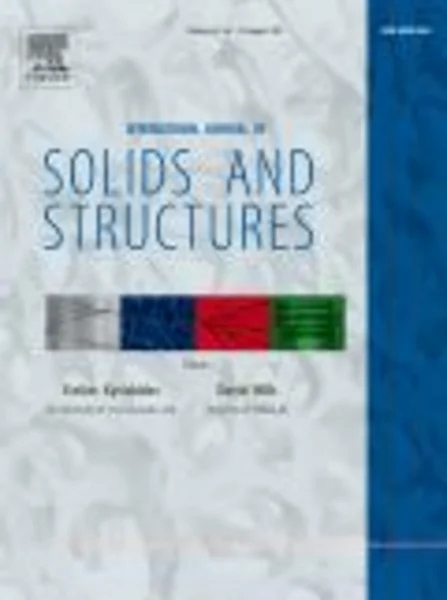-
on thermoelastostatics of composites with nonlocal properties of constituents ii. estimation of effective material and field parameters
جزئیات بیشتر مقاله- تاریخ ارائه: 1392/01/01
- تاریخ انتشار در تی پی بین: 1392/01/01
- تعداد بازدید: 740
- تعداد پرسش و پاسخ ها: 0
- شماره تماس دبیرخانه رویداد: -
one considers a linear thermoelastic composite medium, which consists of a homogeneous matrix containing a statistically homogeneous random set of ellipsoidal uncoated or coated heterogeneities. it is assumed that the stress–strain constitutive relations of constituents are described by the nonlocal integral operators, whereas the equilibrium and compatibility equations remain unaltered as in classical local elasticity. the general integral equations connecting the stress and strain fields in the point being considered and the surrounding points are obtained. the method is based on a centering procedure of subtraction from both sides of a known initial integral equation their statistical averages obtained without any auxiliary assumptions such as, e.g., effective field hypothesis implicitly exploited in the known centering methods. in a simplified case of using of the effective field hypothesis for analyzing composites with one sort of heterogeneities, one proves that the effective moduli explicitly depend on both the strain and stress concentrator factor for one heterogeneity inside the infinite matrix and does not directly depend on the elastic properties (local or nonlocal) of heterogeneities. in such a case, the levin’s (1967) formula in micromechanics of composites with locally elastic constituents is generalized to their nonlocal counterpart. a solution of a volume integral equation for one heterogeneity subjected to inhomogeneous remote loading inside an infinite matrix is proposed by the iteration method. the operator representation of this solution is incorporated into the new general integral equation of micromechanics without exploiting of basic hypotheses of classical micromechanics such as both the effective field hypothesis and “ellipsoidal symmetry” assumption. quantitative estimations of results obtained by the abandonment of the effective field hypothesis are presented.
مقالات جدیدترین رویدادها
-
استفاده از تحلیل اهمیت-عملکرد در ارائه الگوی مدیریت خلاقیت سازمانی و ارائه راهکار جهت بهبود
-
بررسی تاثیر ارزش وجوه نقد مازاد بر ساختار سرمایه شرکت های پذیرفته شده در بورس اوراق بهادار تهران
-
بررسی تأثیر سطح افشای ریسک بر قرارداد بدهی شرکت های پذیرفته شده در بورس اوراق بهادار تهران
-
بررسی تأثیر رتبه بندی اعتباری مبتنی بر مدل امتیاز بازار نوظهور بر نقد شوندگی سهام با تأکید بر خصوصی سازی شرکت ها
-
تأثیر آمیخته بازاریابی پوشاک ایرانی بر تصویر ذهنی مشتری پوشاک ایرانی (هاکوپیان)
-
تغییرات شاخص کاویتاسیون در تخلیه کننده تحتانی شماره 3 سد سفیدرود در حالت هوادهی شده و هوادهی نشده به کمک fluent
-
نقش خانواده در اقتصاد مقاومتی
-
بررسی عوامل موثر در وفاداری به برندهای داخلی در صنعت پوشاک از منظر اقتصاد مقاومتی
-
مدل سازی راهبری شرکتی بر اجتناب مالیاتی و خطر سقوط قیمت سهام با استفاده از الگوی لاجیت
-
بررسی صنعت تشبیه و همانندسازی در سیر آثار و اشعار نزار قبانی
مقالات جدیدترین ژورنال ها
-
مدیریت و بررسی افسردگی دانش آموزان دختر مقطع متوسطه دوم در دروان کرونا در شهرستان دزفول
-
مدیریت و بررسی خرد سیاسی در اندیشه ی فردوسی در ادب ایران
-
واکاوی و مدیریت توصیفی قلمدان(جاکلیدی)ضریح در موزه آستان قدس رضوی
-
بررسی تاثیر خلاقیت، دانش و انگیزه کارکنان بر پیشنهادات نوآورانه کارکنان ( مورد مطالعه: هتل های 3 و 4 ستاره استان کرمان)
-
بررسی تاثیر کیفیت سیستم های اطلاعاتی بر تصمیم گیری موفق در شرکتهای تولیدی استان اصفهان (مورد مطالعه: مدیران شرکتهای تولیدی استان اصفهان)
-
بررسی تاثیر کالبد و کارکرد فضاهای ورودی شهر در ایجاد حس دعوت کنندگی شهروندان نمونه موردی ورودی های شرق شهر تهران
-
بررسی اثر نوع و غلظت امولسیون کننده های خوراکی بر پایداری محلول دهانشویه با رویکرد طراحی آزمایش
-
بررسی تاثیر اینترنت اشیاء بر حمل و نقل در کلان شهرها
-
بررسی قیمت نفت و تولید ناخالص داخلی و انتشار دی اکسید کربن و رابطه سیستماتیک رشد اقتصادی با مصرف انرژی تجدیدناپذیر در کشورهای اسلامی عضو اوپک
-
بررسی رابطه سرمایه نمادین ایرانی – اسلامی با سرمایه فکری




سوال خود را در مورد این مقاله مطرح نمایید :